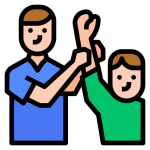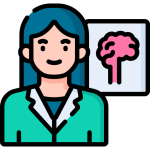Occupational and Physical Therapists
Occupational Therapists (OTs):
Many stroke survivors experience changes in their physical, cognitive, and emotional abilities that make daily activities related to work, school, parenting or leisure difficult.
Following hospital discharge, occupational therapists (OTs) focus on helping patients become as functional as possible. Often this includes caregiver education and training.
Other OT interventions include home modifications, assistive technology training, and wheelchair prescriptions for improving quality of life and increasing independence.
OTs collaborate with patients, families, and caregivers to determine which activities are necessary, meaningful, and/or relevant to them. Examples include:
- Helping patients reacquire self-care skills
- Teaching adaptive tasks that help the person to safely perform activities of daily living (ADLs)
- Addressing ongoing deficits such as weakness, sensory loss, and cognitive or visual impairments
- Community reintegration and modifying tasks or environments
- Training in the use of assistive technology, to maximize independent ADLs
- Performing work-related task analysis and work site evaluations, and recommending modifications as needed
- Evaluating and treating swallowing difficulties
- Developing coping strategies to support psychosocial health, well-being, and self-care
- Teaching and promoting healthy lifestyle habits and routines to minimize the risk of a subsequent stroke
- Developing strategies to overcome barriers to sexual intimacy
- Providing driving readiness evaluations and any necessary equipment recommendations
Physical Therapists (PTs)
Physical therapists (PTs) are another essential component of a stroke rehabilitation team. They are specially trained in treating disabilities related to motor and sensory impairments.
PTs help with problems with movement and balance. They teach their clients exercises to strengthen muscles for walking, standing, and other activities. PTs employ a wide range of tools and techniques that help build muscle mass, improve range of motion, and increasing endurance.
Stroke often causes weakness or loss of function on one side of the body. This is called hemiparesis. PTs use strategies to encourage the use of impaired limbs. These strategies may include tapping or stroking, active and passive range-of-motion exercises, and temporary restraint of healthy limbs while practicing motor tasks.
When evaluating a stroke survivor, PT’s will assess:
- Strength
- Endurance
- Range of motion
- Gait abnormalities
- Sensory deficits
From their assessment, PT’s will create an individualized rehabilitation program aimed to target the stroke survivors’ impairments. Rehabilitation plans may focus on:
- Regaining the use of impaired limbs
- Teaching compensatory strategies to reduce effects of deficits
- Establishing ongoing exercise programs to retain learned skills
Explore the links below to learn more about some of the healthcare providers that may be part of your team.
Speech-Language Pathologists

Occupational and Physical Therapists

Neurologists and Cardiologists

Case Managers and Social Workers

Nurse
Practitioners

Dietitians and
Nutritionists

